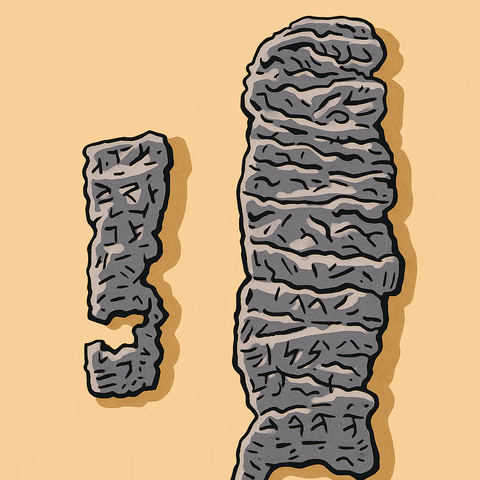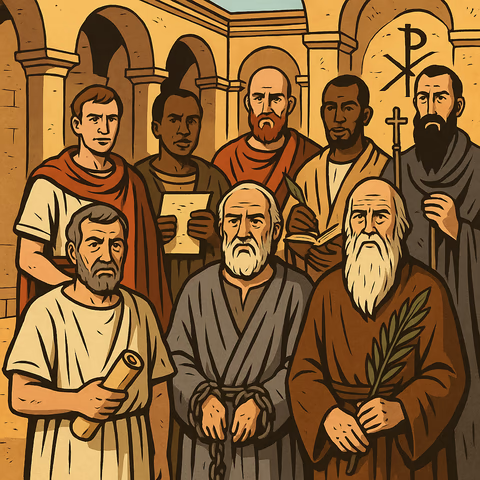
Timeline of God’s Name
God’s Name is a very ancient concept. It’s use decreased dramatically after the Babylonian exile, but it’s still used today.
This timeline shows the history of God’s Name, Jehovah/Yahweh, its use, and how it changed over time.
Why important for us
It’s important to understand how the use of God’s Name changed over time, as we need to know how to translate it correctly. This is because in many manuscripts, it appears as circumlocutions.
Timeline
Pre-Flood Era
Enos ‘Calls’ upon the Name

Genesis 4:26 speaks of a man named Enos who began to ‘call’ on God’s Name. Our Greek Septuagint translation says this:
‘Enos, who hoped to call upon the Name of The God’
If this is a literal reference to the ‘Name’ (and not a reference to what God stands for or something like that), it would indicate that the Name was already known and used long before Abraham, Moses, or the nation of Israel even existed.
~1526 BC
The God’s Name Described to Moses

Exodus reports God Himself tells Moses His personal Name:
‘YHWH (Jehovah/Yahweh; Hebrew: יהוה) – that has been My Name through the ages, and it’s how I shall be remembered from generation to generation.’ –Exodus 3:15.
This pivotal moment occurred just before the Israelite’s departure from Egypt. God not only tells Moses His Name, but also reveals its meaning.
Note how it reports that the Name was already known ‘through the ages’. This could indicate that this was not when the Name was first revealed to the Israelites, that it was already known and used.
~14th Century BC
Oldest Archaeological Evidence?

The God’s Name may appear in an Egyptian temple inscription at the ruins of the Soleb Temple in modern-day Sudan. Literally, it says:
‘tꜣ šꜣsw Yhwꜣ'.
This could be translated as:
‘…those of Yahwa’.
Or possibly:
‘…the nomads of Yahwa’.
The inscription is dated to the 14th century BC, which is during the time of the Israelite Judges (after Moses but before King David).
If this truly is a reference to the Yahweh and the Israelites, it would mean that the Israelites were known by their God’s name and that even foreign nations knew it. After all, in Exodus 5:2, Pharaoh asked:
‘Just who is this Yahweh, that I must pay attention to anything He has to say’?
~7th Century BC
The Silver Scrolls

The oldest record of the Name in sacred writings is found in the Ketef-Hinnom Scrolls (also known as the ‘Silver Scrolls’), containing words from Numbers 6:24-26.
These are dated to just before the destruction of Solomon’s temple, showing that the Name was in common use at that time, exactly as we see recorded in the writings of prophets like Isaiah and Jeremiah.
~6th Century BC
Avoidance of God’s Name Begins

Around the time of the Jewish exile to Babylon, a custom developed among the Israelites to avoid pronouncing God’s Name out of reverence or shame over their exile.
They began to substitute it with circumlocutions, such as Marah (Aramaic for ‘Lord’) and MarYah (Aramaic for ‘Highest Lord’, usually reserved for God’s Name).
~3rd-1st Century BC
The Septuagint’s ‘Lord’
In the Greek Septuagint (LXX), God’s Name was often replaced with the circumlocution kyrios (‘Lord’). However, it was frequently used without the definite article (‘the’), serving as a subtle signal to readers that God’s personal Name had been replaced.
At least one copy of the Septuagint, the 4Q120, transliterates the Name into the Greek letters ΙΑΩ. Also, some copies found in Israel contain the Name in Hebrew letters.
1st Century AD
Pronunciation Reserved for the High Priest
During this period, Rabbinic sources indicate that God’s Name was pronounced only once a year by the High Priest, on the Day of Atonement, in the Temple. This custom arose out of deep reverence for the Name. Other Jewish sources from this era, like Philo, also attest to the strict prohibition against uttering the Name by ordinary individuals.
1st Century AD
The New Testament Uses Circumlocutions
The Greek New Testament also largely followed the Septuagint’s practice of using circumlocutions for God’s Name, typically replacing it with kyrios (‘Lord’) without the definite article (‘the’), just as the Septuagint did.
Aramaic versions of New Testament books would use the title MarYah (‘Lord’ or ‘Highest Lord’), a spelling of ‘Lord’ that was almost exclusively used to replace God’s Name.
- Learn more: God’s Name in Christian Texts
AD ~400
Western Christian Translations
Jerome’s Latin Vulgate, a highly influential translation for Western Christianity, continued the tradition of replacing God’s Name with ‘Lord’ (Dominus in Latin), further cementing its absence in mainstream translations for centuries.
1611
The King James Version
Famously, the King James Version, despite generally following the tradition of replacing God’s Name with 'LORD' (in small capitals), notably used 'Jehovah' in these places:
The Modern Era
The Name Becomes Well-Known

The name, whether as Jehovah, Yahweh, or YHWH, becomes more widely known among scholarship and the general public:
- It appears in some hymns, such as Guide Me O Thou Great Jehovah.
- It is included in the decorations of some homes, churches, and other buildings.
- It is occasionally seen in popular culture, such as in a scene from Indiana Jones and the Last Crusade.
- Groups like the Assemblies of Yahweh, Jehovah’s Witnesses, and the Congregation of Yahweh promote it.
Learn more
Timelines: Bible History
 Timeline of the Kings of Israel and Judah
Timeline of the Kings of Israel and Judah Timeline of the Maccabeean Period
Timeline of the Maccabeean Period Timeline of the Jewish-Roman Wars
Timeline of the Jewish-Roman Wars Timeline of Jesus' Death and Resurrection
Timeline of Jesus' Death and Resurrection Timeline of the Babylonian Exile and Restoration
Timeline of the Babylonian Exile and Restoration
Timelines: Doctrines
 Timeline of Church Fathers and their Doctrines
Timeline of Church Fathers and their Doctrines Timeline of the Trinity Doctrine
Timeline of the Trinity Doctrine Timeline of Afterlife Doctrines
Timeline of Afterlife Doctrines Timeline of God's Name
Timeline of God's Name
Timelines: Miscellaneous
 Timeline of Bible Canon Formation
Timeline of Bible Canon Formation Timeline of Bible Translation
Timeline of Bible Translation Timeline of Church Schisms, Gnostics, and Sects
Timeline of Church Schisms, Gnostics, and Sects Timeline of Failed Apocalyptic Predictions
Timeline of Failed Apocalyptic Predictions
Also see our Articles index and our About section.